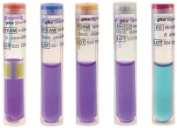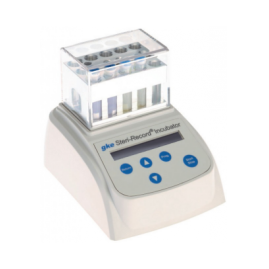Product Description
The gke Steri-Record® Mini-Bio-Plus SCBI uses a plastic vial with a minimized internal volume containing a biological indicator spore disc and a glass ampoule with a growth medium and pH-indicator inside. For steam, ethylene oxide* and formaldehyde sterilization processes, filter paper is used as a carrier and as a closing filter below the cap. For hydrogen peroxide/plasma sterilization processes plastic material is used. For a better recognition of the different SCBI versions they each have different coloured caps (see table).
The outside label of the SCBI contains a class 1 chemical indicator according to EN ISO 11140-1 to check, if the SCBI has been in a sterilization process. Additionally the Instant-Mini-Bio-Plus SCBI also contains a class 5 chemical indicator inside the SCBI allowing the result of steam sterilization processes to be instantly evaluated at the end of the process. Therefore, it is not necessary to wait for the outcome of the SCBI incubation since the class 5 indicator provides equivalent or better information about the result of the sterilization process according to the above chemical indicator standard. The specially designed and patented gke Steri-Record® Bio-C-PCDconstruction consists of a large initial internal volume with a stainless steel tube inside and a minimal capsule volume at the closed end. It can be used only with the specially designed MiniBio-Plus SCBIs as described before, to create a high sensitive Hollow Load PCD. Conventional SCBIs cannot be used because of the lower sensitivity for air removal and steam penetration inside the PCD. For incubation of all SCBIs gke Steri-Record®incubators with two different temperatures and programming versions are available (see separate data sheet).
Performance Characteristics
Self-contained biological indicators: All gke biological indicators comply with the standard EN ISO 11138 series and meet the performance characteristics published in the current United States Pharamcopeia (USP) and European Pharmacopeia (EP). For hydrogen peroxide sterilization processes the standard EN ISO 11138-6 draft is currently under development and not yet available. gke Mini-Bio-Plus SCBIs for hydrogen peroxide sterilization processes are supplied with a D-Value that is tested under the defined sterilization conditions described in the certificate. The SCBIs for Low Temperature Steam Formaldehyde (LTSF) sterilization processes contain in the growth medium substances, decomposing remaining absorbed formaldehyde, so that the pretreatment with Na2SO3 according to EN ISO 11138-5 is not required anymore and the results can be obtained much faster.The incubation time of all Mini-Bio-Plus SCBIs has been optimized, so that steam and H2O2-Mini-Bio-Plus SCBIs can be fully interpreted within 24 hours and ethylene oxide and formaldehyde Mini-Bio-Plus SCBIs within 48 hours incubation time. The SCBIs do not contain additional enzymes and do not require fluorescent light for evaluation and therefore, standard incubation can be used. If the incubation time exceeds the recommended time, the colour of the media does not change back, as some conventional SCBI media do. If the sterilization process is unable to kill the spores, in most cases the colour change will already occur within 5-8 hours.While Steam-Mini-Bio-Plus SCBIs may be used for all steam sterilization processes of 121-137°C, InstantSCBIs shall be used for processes of 132-137°C only and contain a class 5 indicator according to EN ISO 11140-1. The indicator enables the user to interpret the result immediately at the end of the process. The result of a class 5 indicator provides a much higher probability of sterility compared to the result of a SCBI incubation after 3 hours where the probability of < 99 % is achieved after this minimal incubation time only.
Special test systems using Bio-C-PCDs and SCBIs inside:
Bio-C-PCD s with gke SCBIs inside can simulate porous loads and hollow devices simultaneously. A special Bio-C-PCDto simulate the hollow load device described in EN 867-5 is available as well. Additional Bio-C-PCDs are available to simulate different load configurations and may be validated according to the test method, described in DIN 58921.




